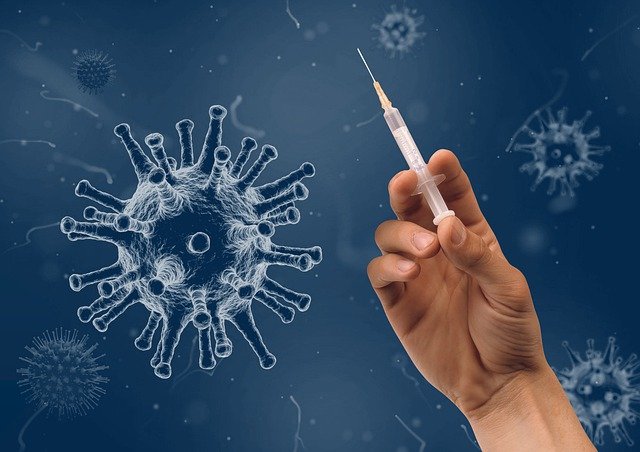By Laura Keil
The Province has announced that more than 300,000 front-line workers, including first responders, grocery store employees, teachers, and child care workers, will be eligible for COVID-19 vaccinations over the coming weeks, allowing them to get their shot earlier than their age would allow otherwise. This comes just a day after Northern Health announced that large industrial project workers living in “high-risk industrial settings,” such as Trans Mountain workers in Valemount, will also receive their shots early.
Beginning in the next few days, approximately 15,000 doses of AstraZeneca – SII Covishield vaccine will be sent to industrial work sites in the Northern Health region. Industry will be responsible for delivering vaccine to their workforces, at their own clinic sites, Northern Health said. The first priorities are work forces of Trans Mountain Pipeline, LNG Canada, Coastal GasLink, BC Hydro’s Site C project, and Rio Tinto Alcan.
Beginning in April, people in priority groups identified by public health and the COVID-19 Workplace Task Group will start to receive their first dose of the AstraZeneca/SII COVISHIELD (AZ/SII) vaccine.
Booking arrangements for front-line workers will be established in the coming weeks. The Province says workers identified as “front-line” and prioritized for the AstraZeneca vaccine should not call into regional health authority call centres at this time.
The priority groups include:
* first responders (police, firefighters, emergency transport);
* K-12 educational staff;
* child care staff;
* grocery store workers;
* postal workers;
* bylaw and quarantine officers;
* manufacturing workers;
* wholesale/warehousing employees;
* staff living in congregate housing at places such as ski hills;
* correctional facilities staff; and
* cross-border transport staff.
These priority groups have been identified as workers in places and sectors where:
* the use of personal protective equipment and barriers can be challenging;
* outbreaks and clusters have occurred or are ongoing;
* workers must live or work in congregate settings; or
* maintaining the workforce for a critical service is necessary.
“Our age-based rollout is ahead of schedule and with the AstraZeneca/SII supply arriving, we can protect people working in specific, front-line industries,” said Adrian Dix, Minister of Health. “Following the latest science and data to identify high-risk industries or critical services will allow us to protect even more people from COVID-19, which in turn, gives our entire communities and our province greater protection from the virus.”
The first shipment of AZ/SII is being deployed to protect people in workplaces identified as having the highest risk of COVID-19 transmission, including food processing plants, including poultry, fruit and fish processing; agricultural operations with congregate worker accommodations, including farms, nurseries and greenhouses; and large industrial camps with congregate accommodations for workers.
The Province says workers, workplaces and industries prioritized in B.C.’s plan have been identified based on recommendations and input of a number of national and provincial groups, including the National Advisory Committee on Immunization, COVID-19 Workplace Task Group and B.C.’s Immunization Committee.
“The additional supply of the AstraZeneca/SII vaccine allows us to strategically target immunizations to maximize the protection of our province,” said Dr. Bonnie Henry, B.C.’s provincial health officer. “With each person who receives any of our three safe and effective vaccines, we are all that much safer.”
In total, B.C. expects to receive approximately 340,000 doses of the AstraZeneca vaccine by the end of May 2021. The Province will use a combination of community pharmacists, existing immunization clinics and mobile clinics at some worksites to administer the AstraZeneca vaccine to front-line workers.
“We have made significant progress after some initial challenges and we can proudly say that we are on track to have everyone immunized by this summer,” said Dr. Penny Ballem, executive lead, B.C.’s immunization plan roll-out.
Regular roll-out ahead of schedule
The age-based vaccine roll-out using the Pfizer and Moderna vaccines is also accelerating and moving forward ahead of schedule, the Province says, and everyone in B.C. who is eligible for a COVID-19 vaccine will be able to receive a first dose before July 1, 2021.
Currently, every senior born in 1941 or before (80 years old and over) and Indigenous peoples born in or before 1956 (65 years old and over) can phone the Northern Health line at 1-844-255-7555 to book an appointment.
Starting Saturday, March 20, call centres will take calls from those born between the years of 1942 to 1951 (79-70 year olds) and Indigenous peoples born in 1966 and before (55 and over).
This age cohort call-in schedule will begin as follows:
* age 79 and Indigenous peoples 55 and older – Saturday, March 20 at noon
* age 78 – Monday, March 22 at noon
* age 77 – Tuesday, March 23 at noon
* age 76 – Thursday, March 25 at noon
* age 75 – Saturday, March 27 at noon
The call-in schedule for the age 70 to 74 age cohort will be announced in the coming days.
The provincial registration and booking system, both online and by phone, will be implemented starting April 6, 2021, for people between the ages of 65-69.
